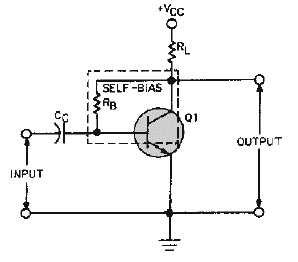2-19
temperature, which cause changes in amplification and even distortion (an unwanted change in a signal).
Thus a need arises for a method to properly bias the transistor amplifier and at the same time stabilize its dc
operating point (the no signal values of collector voltage and collector current). As mentioned earlier,
various biasing methods can be used to accomplish both of these functions. Although there are numerous
biasing methods, only three basic types will be considered.
Base-Current Bias (Fixed Bias)
The first biasing method, called BASE CURRENT BIAS or sometimes FIXED BIAS, was used in
figure 2-12. As you recall, it consisted basically of a resistor (RB) connected between the collector supply
voltage and the base. Unfortunately, this simple arrangement is quite thermally unstable. If the temperature
of the transistor rises for any reason (due to a rise in ambient temperature or due to current flow through it),
collector current will increase. This increase in current also causes the dc operating point, sometimes called
the quiescent or static point, to move away from its desired position (level). This reaction to temperature is
undesirable because it affects amplifier gain (the number of times of amplification) and could result in
distortion, as you will see later in this discussion.
Self-Bias
A better method of biasing is obtained by inserting the bias resistor directly between the base and
collector, as shown in figure 2-13. By tying the collector to the base in this manner, feedback voltage can be
fed from the collector to the base to develop forward bias. This arrangement is called SELF-BIAS. Now, if
an increase of temperature causes an increase in collector current, the collector voltage (VC) will fall because
of the increase of voltage produced across the load resistor (RL). This drop in VC will be fed back to the base
and will result in a decrease in the base current. The decrease in base current will oppose the original
increase in collector current and tend to stabilize it. The exact opposite effect is produced when the collector
current decreases.
Figure 2-13.—A basic transistor amplifier with self-bias.
Self-bias has two small drawbacks: (1) It is only partially effective and, therefore, is only used where
moderate changes in ambient temperature are expected; (2) it reduces amplification since the signal on the
collector also affects the base voltage. This is because the collector and base signals for this particular
amplifier configuration are 180 degrees out of phase (opposite in polarity) and the part of the collector signal
that is fed back to the base cancels some of the input signal. This process of returning a part of the output
back to its input is known as DEGENERATION or NEGATIVE FEEDBACK. Sometimes degeneration is

